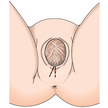
The Pregnancy HelpDesk
|
Episiotomy: |
|
Main Menu | Childbirth Guide |An episiotomy is a surgical incision (cut) made between the vaginal opening and the rectum. This incision is generally around 1/2 an inch long. There are several types of episiotomies. One type is where the doctor cuts straight down from the vaginal opening. Another type is where the doctor cuts at an angle from the vaginal opening. This later incision is usually more preferred by doctors because of its ability to prevent further tearing from the incision. The straight down cut may lead to tearing further down and possibly into the rectum.

Many women fear the thought of being cut in such a sensitive area. Some doctors routinely do an episiotomy to prevent tearing. An episiotomy does heal much faster than a tear. Other doctors will wait until the baby's head begins to emerge and watch for any signs of tearing. Some doctors are very experienced and can see when or if tearing is about to occur and they will then make the incision (during the pushing stage). Some women do not need to have an episiotomy.
Will it hurt During the Incision?
During labor, the doctor will usually perform the incision before the pushing stage to prevent tearing. Or, they may wait to check for signs of tearing and perform the incision during the pushing stage. If you have an epidural, you will not feel any pain in your vaginal area although you may feel pressure. If you do not have an epidural, generally doctors will give a local anesthetic to the vaginal area. This is called a
pudenial block.Is there anything I can do To Prevent an Episiotomy?
The only known exercise that can help prevent an episiotomy is kegel exercises. These exercises are performed by tightening the muscles of the vagina. To do the exercise, imagine that you are urinating and stopping the flow of urine. Hold this tightening and then slowly release. You should try to do these exercises about 15-20 times several times during the day. The more you do these exercises the less likely you will be to have to have an episiotomy. However, there are times when there is nothing you could do to prevent an episiotomy. These are routine practice of your doctor, large baby, small vaginal opening, and/or breech presentation of the baby.
How do I take Care of an Episiotomy?
After you have had an episiotomy, you should keep the area very clean. Some hospitals will give you a water spray bottle to squeeze water on the vaginal area after urinating or if you just trying to relieve pain. After you urinate you should use this spray bottle to prevent infections of the episiotomy. The bottle should be filled with as warm as you can stand water. After spraying the area with the water, you can use an aerosol type anesthetic that the hospital provides or call your local pharmacy. This anesthetic is very soothing, but may burn at first. Another pain reliever that works great with episiotomies is TUCKS. Just put one or two on top of your sanitary napkin. If you have hemorrhoids, use these also. They will feel cool and may relieve some pain. Once they lose their coolness, replace with more.
How Long Will It Take To Heal?
The episiotomy generally takes about 4 - 6 weeks to heal. After about two weeks it feels much better. During the healing process, you should try to continue the Kegel exercises to strengthen and tone the area. This will raise the blood flow to the area and provide faster recovery.
How Long Do I Have To Wait to Resume Sexual Relations?
You should wait until your 6 week checkup to resume sexual relations. The reasoning is that you may not be aware of an infection or an area that has not completely healed. If you have sex too soon before the healing, you can stretch the vaginal area to a small degree, have very painful intercourse or risk infecting the area.
Note: If you should see any redness or have any soreness after you have already begun to heal, please consult your physician.
Related Topics:
Pudenial block (anesthesia to vaginal area)
|
Main Menu | Childbirth Guide |